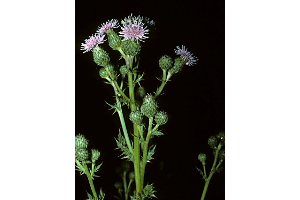Although Cirsium arvense is native to southeastern Europe and eastern regions of the Mediterranean, it has spread to most of the temperate areas of the world. It was accidentally introduced into North America during the 17th century as a contaminant in crop seed. Today, in cooler areas of North America, the plant is especially troublesome and hard to keep under control.
Photo Credit: © T.F. Niehaus. Courtesy of Smithsonian Institution, Dept. of Systematic Biology, Botany.
Cirsium arvense
Common Name: Canada thistle
Other Common Names: Californian thistle, creeping thistle, field thistle
Plant Functional Group: Forb
Class > Order > Family: Magnoliopsida > Asterales > Asteraceae
What does the species look like?
Canada thistle is an erect, perennial, herbaceous plant growing 1 to 5 feet tall, with some branching along slightly hairy stems. Male and female flowers occur separately on different plants. Tiny, rose-purple, lavender or white flowers are tightly clustered into flowerheads appearing like a single flower at the top of the branches. Plants are often connected by underground roots and form large patches. These connected plants will typically produce only one sex of flowers.
Canada thistle prefers deep, well-aerated, cool soils, and is less common in light, dry soils. It grows best in disturbed areas (pastures, old fields, waste places, fence rows, roadsides, and along railroads). It is occasionally found in wet areas where water levels fluctuate (stream banks, ditches), and can invade sedge meadows and wet-mesic grasslands. It also grows along lakeshores, seashores, sand dunes, and open sandy areas.
Where is the species found?
States & Provinces
AB, AK, AL, AR, AZ, BC, CA, CO, CT, DC, DE, IA, ID, IL, IN, KS, KY, MA, MB, MD, ME, MI, MN, MO, MT, NB, NC, ND, NE, NH, NJ, NL, NM, NS, NT, NV, NY, OH, ON, OR, PA, PE, QC, RI, SD, SK, TN, UT, VA, VT, WA, WI, WV, WY, YT
Special Considerations for Observing
If drought seems to be the cause of leaf senescence for a plant, please make a comment about it for that observation.
Which phenophases should I observe?
Do you see...?
Leaves
Initial growth More...
Leaves More...
Flowers
Flowers or flower buds More...
How many flowers and flower buds are present? For species in which individual flowers are clustered in flower heads, spikes or catkins (inflorescences), simply estimate the number of flower heads, spikes or catkins and not the number of individual flowers.
Less than 3 3 to 10 11 to 100 101 to 1,000 More than 1,000
Open flowers More...
What percentage of all fresh flowers (buds plus unopened plus open) on the plant are open? For species in which individual flowers are clustered in flower heads, spikes or catkins (inflorescences), estimate the percentage of all individual flowers that are open.
Less than 5% 5-24% 25-49% 50-74% 75-94% 95% or more
Fruits
Fruits Cirsium arvense , the fruit is very tiny and seed-like and is crowded into a spent flower head. The seed-like fruit has a tuft of white fluff, and changes from whitish-yellow or yellow-green to tan, light yellow or light brown and drops or is blown from the plant after the spent flower head reopens. Do not include empty flower heads that have already dropped all of their fruits.More...
How many fruits are present?
Less than 3 3 to 10 11 to 100 101 to 1,000 More than 1,000
Ripe fruits Cirsium arvense , a fruit is considered ripe when the spent flower head has reopened and the white fluff is visible. Do not include empty flower heads that have already dropped all of their fruits.More...
What percentage of all fruits (unripe plus ripe) on the plant are ripe?
Less than 5% 5-24% 25-49% 50-74% 75-94% 95% or more
Recent fruit or seed drop More...
How many mature fruits have dropped seeds or have completely dropped or been removed from the plant since your last visit?
Less than 3 3 to 10 11 to 100 101 to 1,000 More than 1,000
What do these phenophases look like?
The following Phenophase Photo Guides for this species have been vetted for accuracy by the USA-NPN National Coordinating Office. Most photo guides are developed for a particular local or regional monitoring effort, and some of the content may not apply to your effort or your region. However, we make them available to provide as much help as they may in illustrating phenophases for this species. If you have high quality phenophase photos that you are willing to share with us, please visit the Phenophase Photo Guidelines page.
Be aware there is variation from individual to individual within a species, especially across different regions, so your plant may not look exactly like the one pictured.
Since they do not always include complete definitions for the species, use these photo guides ONLY in conjunction with the official Nature's Notebook phenophase defintions included in the table above, in the phenophase definition sheet that downloads with the datasheet, or in the Observe screen in the mobile app.
